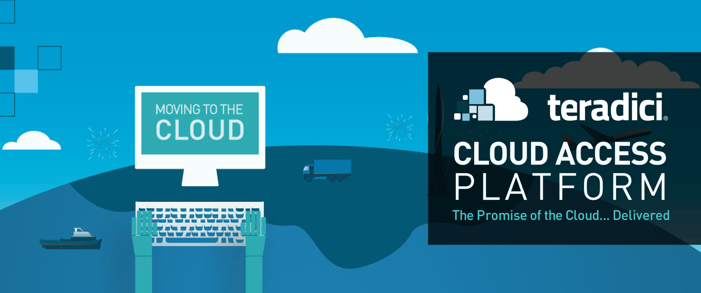Dan Cordingley
Dan is a veteran of the semiconductor, communications standard, and networking industries with more than 20 years’ experience managing business initiatives and driving revenue growth. As a co-founder, Dan has been with Teradici since 2004, and has overseen tremendous growth, and expansion into new markets and vertical industries. Prior to co-founding Teradici, Dan was a general manager with Intel Corporation, where he oversaw the Digital Subscriber Line (DSL) silicon business unit, which was market leader in key segments during his tenure. Before Intel, Dan was a general manager and director at Level One Communications, a leading supplier of networking and telecom semiconductors that was acquired by Intel in 1999. Under Dan's leadership, Level One conceived, standardized, and delivered several important communications standards in widespread use today. Dan has also held senior marketing and design engineering roles at Mitel Semiconductor (now Zarlink), Spectrum Signal Processing, Nortel Networks and IBM. Dan holds a bachelor's degree in Electrical Engineering from the University of Waterloo, and an MBA from the Ivey School of Business at the University of Western Ontario.
Welcome to the brand-new Teradici Blog!
Where do we start? For this first post, it seemed most appropriate to start right at the beginning. We asked our president and co-founder, Dan Cordingley to reflect on Teradici's origins and how this history might help shape the future of the cloud.
 Photo credit.
Photo credit.Way back before iPhones, YouTube & Philz Coffee, I worked with several successful companies in networking and communications technology. Then, while working at a leading venture capital firm with one of my co-founders, Dave Hobbs, it occurred to us that a better, more robust networking protocol could change the way we think about computing.
What if we could deliver a remote (or centralized) computing experience that was actually better than a physical computer?
What if we could deliver a remote (or centralized) computing experience that was actually better than a physical computer? What if we could reduce overhead and increase accessibility all while improving security? The possibilities seamed limitless. So back in 2004, Dave and I set out to find a way to do just that.
And with that, Teradici was born...
In those days, ‘cloud computing’ was little more than a concept. So, when we emerged from stealth mode in 2007, we found a niche in the high-end workstation market. Our new protocol, PCoIP, made it possible to securely transmit data to a remote client in a pixels-only format, adapting on-the-fly to network conditions so that, from a user perspective, there was no difference between working with a local computer or a zero client. PCoIP was a hit!
Movie and animation studios, trading floors, automotive companies, all embraced our PCoIP technology and could not believe the performance we could deliver for graphics intensive, rich applications.
PCoIP made it possible to securely transmit data... in a pixels-only format, adapting on-the-fly to network conditions.
We then forged a strategic partnership with VMware in the Virtual Desktop Infrastructure (VDI) market, where users could remotely connect (via PCoIP) to virtual desktops running on centralized servers. Within a few years, millions of users around the world jumped on board with security-conscious healthcare, government, military, education and retail industries leading the way. At the same time, we rounded out our PCoIP Zero Client partner ecosystem to include leaders such as Dell, LG, HP and Samsung.

The year of DaaS
As our momentum (and general broadband accessibility) grew, so did the promise of the cloud. The flexibility and scalability offered by the cloud could no longer be ignored and in 2013, we reached a turning point. VMware launched Horizon DaaS, and Amazon Web Services launched Amazon WorkSpaces: desktops that could be delivered entirely from the cloud, scaling up or down within minutes. How? PCoIP technology. Desktop-as-a-Service became viable for those without the IT resources (or inclination) to build their own infrastructure.

The cloud is here
Today, the cloud has become mainstream. Our goal at Teradici is to help organizations deliver on all the wonderful promises of the cloud. So last year, we launched the Teradici Pervasive Computing Platform, offering any solution developer the same access to our PCoIP technology that was once exclusive to the likes of AWS and VMware.
With the Teradici Platform, organizations can now build solutions and deliver any application via PCoIP from the cloud platform of their choice (AWS, Google Cloud, IBM Softlayer, Microsoft Azure, etc.).
Where we’re headed
Imagine if we had no prior knowledge of computing before today, just the requirements for work: flexibility, mobility, high-performance, security and more. Chances are we’d design something that would bring the power of the cloud to any user in any environment, accessing their applications, from any device, anytime. This is our vision.
Our leading position in this industry gives us a unique insight into the past, present and future of cloud computing and so by launching this blog, we hope to become a resource and a partner for your vision. We invite and look forward to dialogue and participation from you, the architects and developers of this incredible cloud transition.
We can’t wait to see what you build!

Dan Cordingley
Dan is a veteran of the semiconductor, communications standard, and networking industries with more than 20 years’ experience managing business initiatives and driving revenue growth. As a co-founder, Dan has been with Teradici since 2004, and has overseen tremendous growth, and expansion into new markets and vertical industries. Prior to co-founding Teradici, Dan was a general manager with Intel Corporation, where he oversaw the Digital Subscriber Line (DSL) silicon business unit, which was market leader in key segments during his tenure. Before Intel, Dan was a general manager and director at Level One Communications, a leading supplier of networking and telecom semiconductors that was acquired by Intel in 1999. Under Dan's leadership, Level One conceived, standardized, and delivered several important communications standards in widespread use today. Dan has also held senior marketing and design engineering roles at Mitel Semiconductor (now Zarlink), Spectrum Signal Processing, Nortel Networks and IBM. Dan holds a bachelor's degree in Electrical Engineering from the University of Waterloo, and an MBA from the Ivey School of Business at the University of Western Ontario.
Posts by Tag
- Cloud Access Software (74)
- PCoIP (69)
- Cloud Computing (43)
- Media & Entertainment (40)
- Cloud Access (38)
- HP Anyware (38)
- PCoIP Technology (35)
- Zero Client (30)
- Teradici CAS (29)
- hybrid work (29)
- AWS (27)
- VDI (23)
- PCoIP Zero Clients (22)
- Amazon Workspaces (21)
- NVIDIA (21)
- CAS (20)
- Microsoft (20)
- PCoIP Ultra (20)
- Azure (19)
- Cloud Access Plus (19)
- Microsoft Azure (19)
- Google Cloud (18)
- GPU (17)
- VMware (17)
- Virtualization (15)
- Cloud Desktops (14)
- Remote Workstation (14)
- VFX (14)
- remote work (14)
- Amazon Web Services (13)
- VMware Horizon (13)
- cloud graphics (13)
- digital workspaces (13)
- Data Security (12)
- Google (12)
- Cloud Workflows (11)
- Amazon (10)
- Cloud Migration (10)
- End-point Security (10)
- GPUs in the Cloud (10)
- Remote Working (10)
- Virtual Desktops (10)
- DaaS (9)
- protocol (9)
- Autodesk (8)
- Cloud (8)
- Dell (8)
- Ian Main (8)
- Pervasive Computing Platform (8)
- SIGGRAPH (8)
- Security (8)
- virtual workstations (8)
- Cloud Workspaces (7)
- Game Development (7)
- Gaming (7)
- Hybrid Cloud (7)
- Interview (7)
- PCoIP Workstation Access Software (7)
- Remote Display Protocols (7)
- Video Editing (7)
- architecture (7)
- macos (7)
- multicloud (7)
- remote visualization (7)
- 3D graphics (6)
- Architecture Engineering Construction (6)
- Blast Extreme (6)
- Blast Extreme Vs PCoIP (6)
- CAD (6)
- COVID-19 (6)
- Cloud Access Platform (6)
- Collaboration (6)
- Desktop Access (6)
- Events (6)
- H.264 (6)
- HP (6)
- Hardware Accelerator (6)
- Horizon Protocols (6)
- NVIDIA Grid (6)
- Wacom (6)
- remote workforce (6)
- AMD (5)
- AWS re:Invent (5)
- Adobe (5)
- All Access (5)
- CAM (5)
- Cloud Security (5)
- Getting to know... (5)
- IGEL (5)
- Inside Teradici (5)
- NABShow (5)
- PCoIP Management Console (5)
- Q & A (5)
- Remote worksation (5)
- Thin Clients (5)
- Webinar (5)
- coronavirus (5)
- quarantine (5)
- remote graphics (5)
- Cloud Endpoints (4)
- Cybersecurity (4)
- GPU-Accelerated Cloud (4)
- Google Cloud Platform (4)
- HPE (4)
- Linux (4)
- Microsoft Ignite (4)
- N-Series GPU (4)
- NVIDIA GPU (4)
- Randy Groves (4)
- Remote Workspace (4)
- User Experience (4)
- auto offload (4)
- lossless (4)
- mac (4)
- AWS Marketplace (3)
- Amazon Workspace Graphics Bundle (3)
- Anyware Manager (3)
- Architecture, Engineering, and Construction (3)
- AutoCAD (3)
- Avid (3)
- CAD in the Cloud (3)
- Codecs (3)
- Dan Cordingley (3)
- Disaster Recovery (3)
- GCP (3)
- GTC (3)
- Google Cloud Next (3)
- Google Next (3)
- IBC (3)
- Jellyfish Pictures (3)
- LG (3)
- LucasFilm (3)
- Management Console (3)
- Maya (3)
- Microsoft Azure Marketplace (3)
- NAB (3)
- NVIDIA NVENC (3)
- Qumulo (3)
- Remote Desktop (3)
- Sohonet (3)
- Video (3)
- Virtual Machines (3)
- Workstations in the Cloud (3)
- Zero Client Deployment (3)
- broadcasting (3)
- business continuity (3)
- cas manager (3)
- linux desktops (3)
- movie production (3)
- pcoip encoding (3)
- remote workstation card (3)
- vmworld (3)
- zero trust architecture (3)
- 3D Workflow (2)
- AWS Graphics Bundles (2)
- AWS re:Invent 2018 (2)
- Adobe Premiere (2)
- Alex Herrera (2)
- Alta PCoIP Zero Clients (2)
- Amulet Hotkey (2)
- Apple (2)
- Arjen van der Meulen (2)
- Cloud Access Manager (2)
- Customer Story (2)
- DNEG (2)
- David Smith (2)
- EC2 Elastic GPU (2)
- FIPS (2)
- Federal Government (2)
- HP ZCentral Remote Boost (2)
- HTML5 (2)
- Healthcare (2)
- IBC 2018 (2)
- IBC 2019 (2)
- IBM (2)
- ILM (2)
- Industrial Light & Magic (2)
- Microsoft Build (2)
- Moore's Law (2)
- NVIDIA M60 (2)
- NVIDIA RTX6000 GPU (2)
- Oil & Gas (2)
- Scanline (2)
- Trusted Zero Client (2)
- VMworld 2016 (2)
- Workstation (2)
- Workstation Access (2)
- Z by HP (2)
- aws re:Invent 2019 (2)
- cloud solutions (2)
- data scientists (2)
- emmy (2)
- finance (2)
- hammerspace (2)
- lenovo (2)
- macstadium (2)
- omniverse (2)
- partner solutions (2)
- private cloud (2)
- server offload (2)
- tehama (2)
- virtual studio (2)
- wacom tablet (2)
- 10ZiG (1)
- 4K (1)
- 4K UHD Display (1)
- AEC (1)
- AI (1)
- AWS Endpoints (1)
- AWS Outposts (1)
- Adobe After Effects (1)
- Adobe Creative Suite (1)
- Adrian Graham (1)
- Android (1)
- Animation World (1)
- AnythingIT (1)
- Anyware Connector (1)
- Appsbroker (1)
- ArcGIS Pro (1)
- Atomic Cartoons (1)
- Autodesk 3DS Max (1)
- BCCDC (1)
- BVE (1)
- Bandwidth (1)
- Battery Life (1)
- BeBop Technology (1)
- Beaufort Memorial Hospital (1)
- Big Data (1)
- Brown Bag Films (1)
- CEEF16 (1)
- CP Technologies (1)
- CPU Load (1)
- CRN (1)
- Cadalyst (1)
- Careers (1)
- Celebrating 3 Million PCoIP Zero Clients (1)
- Certificate Management (1)
- Chris Feeney (1)
- Christus Health (1)
- Chrome (1)
- Chromebook (1)
- Cisco (1)
- Clearcube (1)
- Cloud Expo Europe (1)
- Cloud Expo Europe 2016 (1)
- Cloud Foundry Foundation (1)
- Compute (1)
- Connection Health Monitor (1)
- Crafty Apes (1)
- D-Wave (1)
- DISRUPT (1)
- DISRUPT EUC (1)
- DISRUPT Unite (1)
- DISRUPT2019 (1)
- DSB Consulting (1)
- Data Center 100 (1)
- Dell EMC (1)
- Disaster Recovery Plan (1)
- Disney (1)
- Don Listwin (1)
- EUC (1)
- Education (1)
- Elastic GPU (1)
- Emanuel Pirker (1)
- End User Computing (1)
- Esri (1)
- Event (1)
- Facebook (1)
- Fairfield Energy (1)
- Forbes (1)
- Forrest Smith (1)
- G3 Instances (1)
- GIS (1)
- General Availability (1)
- Google Cloud Marketplace (1)
- Google Marketplace (1)
- Government (1)
- Guest Post (1)
- HP RGS (1)
- HP t310 Quad-Display Zero Client (1)
- HP t310 Zero Client (1)
- HPA (1)
- HPE LoadRunner (1)
- HPE ProLiant (1)
- Hewlett Packard Enterprise (1)
- Higher Education (1)
- Hollywood Professional Association (1)
- Hyperclouds (1)
- IT Business Edge (1)
- Imprivata (1)
- Imprivata OneSign (1)
- Intel (1)
- Intel oneAPI Rendering Toolkit (1)
- Jeff Groudan (1)
- Jensen Huang (1)
- Jeremy Smith (1)
- Jon Peddie Research (1)
- Karan Batta (1)
- LDAP (1)
- MESA (1)
- Martin Traute (1)
- Mason City Clinics (1)
- Meltdown (1)
- Metro Health (1)
- Microsoft AVD Deployment (1)
- Mirela Cunjalo (1)
- NAB2017 (1)
- NAB2018 (1)
- NAB2019 (1)
- Neverware (1)
- Nexenta Systems (1)
- Nuke (1)
- OEM (1)
- OpenSDS (1)
- PCoIP Client (1)
- Quad Display (1)
- Quantum Computing (1)
- Rachel Berry (1)
- Rajen Sheth (1)
- Recycle (1)
- Release (1)
- Remote Display Protocol (1)
- SSO (1)
- Sagar Rawal (1)
- Sam Ramji (1)
- Schlumberger (1)
- Single Sign-On (1)
- Softlayer (1)
- Sony Pictures (1)
- Spectre (1)
- Star Wars (1)
- Steve Mueller (1)
- Stratodesk (1)
- Tablet (1)
- Tarkan Maner (1)
- Tech Talk Thursdays (1)
- TechTalk Thursdays (1)
- Tera2 (1)
- Terraform (1)
- The Angry Birds Movie (1)
- The Channel Co. (1)
- The Register (1)
- Thick Clients (1)
- Unigine Heaven (1)
- University of Waterloo (1)
- VDI Server Benchmarks (1)
- VDI Servers (1)
- VMBlog (1)
- VMware Horizon Clients (1)
- Virtual Reality (1)
- Virtualization 50 (1)
- Visualization (1)
- Webinar Series (1)
- Whitepaper (1)
- Work-from-Home Rapid Response Guide (1)
- Wyse (1)
- YOUNGTECH (1)
- Ziad Lamman (1)
- avid media composer (1)
- blade workstation (1)
- brianmadden.com (1)
- cleverDome (1)
- cloud deployments (1)
- community (1)
- connection broker (1)
- covid19 (1)
- dashboard (1)
- fabulatech (1)
- gpu acceleration (1)
- graphics acceleration (1)
- hypervisor (1)
- latency (1)
- leostream (1)
- local termination (1)
- nutanix (1)
- presentation (1)
- project workflows (1)
- promotion (1)
- protocol comparison (1)
- reference architecture (1)
- schools (1)
- studio Q (1)
- survey (1)
- technology partner program (1)
- test & monitoring tool (1)
- training (1)
- usb peripheral support (1)
- validation video (1)
- virtual display devices (1)
- virtual machine (1)
- vmware solution exchange (1)
- vsphere (1)
- webcam support (1)
- windows (1)
- windows virtual desktop (1)
- work from home (1)
- wvd (1)
- zero trust (1)